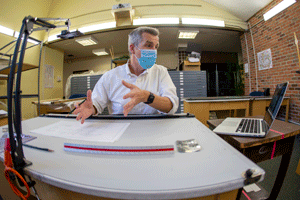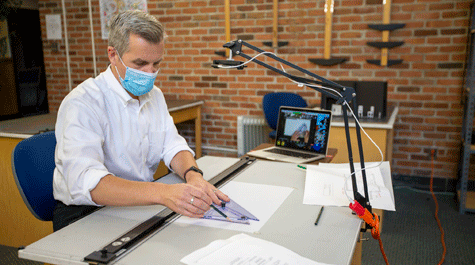Professor retools W&M theatrical design course for remote learning
It’s the closest thing to looking over his shoulder that Matthew Allar’s students will get during COVID-19, and he’s making it work.
Allar, associate professor of theatre at William & Mary, completely retooled his Fundamentals of Theatrical Design course for this fall using digital elements. A main one is an overhead camera that shows what he’s drawing while he gives the lessons verbally for students on Zoom.
“All of this is brand new to the class and is in direct response to the adaptive measures W&M is putting in place to make sure that our students have as full of an experience as possible this fall,” Allar said.
In the past, the course was organized around a series of hands-on, real-time demonstrations of a variety of art techniques including several types of drawing, watercolor rendering and scale drafting, according to Allar. He would introduce the tools and instructions and show students how to explore each medium as they observed alongside.
“Of course, this is impossible right now so we’ve all had to innovate,” Allar said. “Without question, the primary skills required of everyone are patience and a willingness to remain open to a different style of interpersonal interaction with each other.”
 To recreate the observational relationship of looking over his shoulder as a technique is demonstrated, the class is using a dedicated drawing and painting camera set up through an iPad and flexible mounting arm. This allows students to have a face-to-face, albeit via Zoom, relationship with Allar as the instructor, but then switch to a second view that focuses directly on the work space, he said.
To recreate the observational relationship of looking over his shoulder as a technique is demonstrated, the class is using a dedicated drawing and painting camera set up through an iPad and flexible mounting arm. This allows students to have a face-to-face, albeit via Zoom, relationship with Allar as the instructor, but then switch to a second view that focuses directly on the work space, he said.
“They can still listen to verbal instruction, while also seeing the art technique utilized in real time,” Allar said. “Additionally, we’re making use of a lot of supplementary online content to reinforce the material we engage with in class. While it’s never going to completely replace the in-person experience, it does offer students a viable way to continue to engage with this material.”
They’re also using free, web-based figure drawing sessions in lieu of in-person models. The class uses the resources together, and then students are able to continue their work remotely on their own.
It’s just one of many ways the Department of Theatre, Speech and Dance has found to continue hands-on teaching with students while adhering to COVID-19 guidelines.
“All of the practice-based classes have been experiencing their own unique challenges,” said Laurie Wolf, theatre professor and chair of the department. “Theatre, speech and dance are such collaborative areas of study that many courses have had to be completely re-imagined.
“How do you teach a full dance class when each student must remain in their own 10-foot square area? Can you teach a millinery class of eight students when the COVID measurements say you only have room for five? There has been a good deal of ingenuity and resourcefulness within the department since March, just in finding new and effective ways to teach.”
Lauren Miller ’22, a student in Allar’s class, said she was initially a little nervous when the course was switched from being in-person to remote.
“As weeks have passed, I have found particular value in demonstrations presented via a camera suspended above a work space,” Miller said. “This format allows us to get a close-up, focused view of the skills being demonstrated, which are then recorded and may be easily referred back to at a later time. There has definitely been a learning curve, but weekly classes have fallen into an effective routine and the online format feels quite natural.”
 She added that Allar has posted supplemental videos and resources and made himself available for extra help, which fills in any gaps.
She added that Allar has posted supplemental videos and resources and made himself available for extra help, which fills in any gaps.
“Personally, I have been taking great advantage of these opportunities for additional guidance and assistance and have enjoyed getting to explore a wide variety of design techniques and styles,” Miller said. “Speaking further to the online format, I have enjoyed the time that we are provided to see and learn from our classmates’ work. Everyone in the course knows each other quite well, and this level of support has been monumental in navigating this new learning environment.”
Maintaining that sense of collaboration and sharing of feedback is one of the main challenges, according to Allar. But the skills being adapted to and stretched for innovation now will serve students well in whatever future career they may choose.
“The challenge for everyone involved in the course is to work together to create the digital equivalent of the supportive in-person studio environment that we’re all missing right now,” Allar said. “This is something that we’re all working on together as the success of a supportive online experience is a shared responsibility between all who are involved in the class. This is a lot to ask, but I’ve been impressed with how W&M students, across the board, have risen to the challenge.”
















